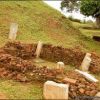දීඝවාපිය
A region in the Uva and Eastern Provinces has suddenly become the subject of controversy in both electronic and print media. Buddhist clergy supported by laymen joined protest campaigns and marched on the streets carrying posters demanding that the Government intervene to protect this area; The subject was Dighavapi.
Many people think Dighavapi is only a Buddhist Dagoba in the Ampara District built during the Second Century BCE. It is true that an enormous Dagoba was built by King Saddatissa, brother of Dutugemunu. According to the Mahawamsa, the Buddha on his third visit to Sri Lanka, after spending the day at the foot of Samanthakuta (Adam's Peak) set out for Dighavapi and seated himself with the brotherhood at the place where the Chetiya (afterwards) stood. He gave himself up to meditation to consecrate the spot.
However, Dipawansa, the older Chronicle says that the Buddha travelling through air went to Dighavapi from Kelaniya Thupa and that "at the place of Dighavapi Chetiya, the Buddha who was full of compassion to the world, descended from the air and again entered upon mystical meditation.
Therefore Dighavapi Chetiya has become one of the sixteen most sacred places of the Buddhists in Sri Lanka.
Dighavapi Mandala or Digamadulla is supposed to be the settlement named after Prince Dighayu, one of six brothers of Baddhakachchayana the queen of King Panduwasadeva. It is said that the Indo-Aryan ancestors of the Sinhalese who came from North India and colonized the Island, named those settlements after them. Similarly, the five other brothers too (of queen Baddhakachchayana) Rama, Uruwela, Anuradha, Vijitha and Rohana had their settlements named after them.
It is also a belief that the word Digha Vapi (long tank) was used to identify this region by the existence of such a reservoir during the reign of Kakawannatissa, father of Dutugemunu, in the 2nd Century BCE. It is possible that one of the tanks in the district was called Dighavapi, named after the district. In "Ancient Irrigation works in Ceylon" R. L. Brohier states that it was "Mahakandiya Wewa" was called Dighavapi.
The Dighavapi was undeniably an ancient work of very great importance. It is occasionally mentioned in the ancient annals, but the reservoir has never been positively identified. However, two very strong clues which assist in attesting almost to a certainty that it is the abandoned tank now known as Mahakandiya Wewa or in the Tamil version Kandia-Kattu.
The first of these clues hinges on very definite data which confines Dighavapi to the South Eastern region of the Island. The other is based on a not unreasonable assumption that one of the characteristics of the old tank has been perpetuated by its name.
The only "long tank" (Dighavapi) in the South East of Ceylon is the totally abandoned work alluded to which has relapsed to its original wild forest. The latest topographical and contour sheets assist more readily than data available in the past





